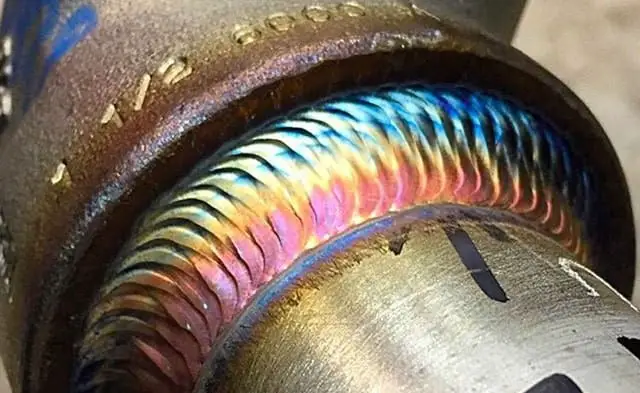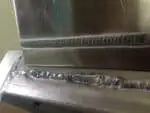A bead weld is the product of a welding pass in which filler material is placed. Since we all know welding is the technique of joining numerous pieces of metal together by heating and softening them, a filler substance is injected between the two components during bead welding.
And when the metal filler material cools, it forms a strong link between the two surfaces.
The sign of a good bead welding is that there should be no surface defects such as undercut, overlap, and inadequate reinforcing. Also, there should be no breaks or holes seen in the bead.
The bead should have regular waves, breadth, and height, and the completed product should meet the design parameters with little deformation.
However, your torch technique also plays an important role in establishing a good bead weld. But what is this torch technique?
When melting a filler material into a workpiece, your balance with the torch and how you move it affects the quality of bead you leave in the joint.
A weld bead can be run along a metal joint in a variety of ways. And usually welders work in odd and uncomfortable positions, wearing face protection and gloves.
To form good quality beads, a welder must make sure of a precise hand stroke along with all the right movements and materials like stick, rod, wire, and selecting the right machine settings.
Let us talk about the different techniques of bead welding-
-
-
- Stringer beads
- Weave beads
-
1.) Stringer beads
A stringer bead is a simple method in which you either drag or push the torch over the joint in a straight line with almost no to little side to side movement.
Usually dragging occurs when the electrode is oriented in the forward welding direction, causing the puddle to move and this allows for optimum penetration and a strong-looking weld.
As welders push the tip of the torch while welding metals that are thin or heat sensitive, or when welding vertically, this tends to necessitate angling your flame away from the puddle and following it as you weld.
Even if you’re working in a straight line, it is important to hook in with the toe of the weld on each side of the joint. Because the objective of welding is not only to fill a connection with new metal, the fusion of the weld and the base metal is essential.
When your torch movement is slow, the weld puddle can run across both sides of the joint. This may be all that is required to produce excellent fusion. But at times when it doesn’t work, a slight side-to-side movement is required.
2.) Weave beads
You can weave from side to side along the joint for broad welding. Weaving is the quickest approach to do a welding project for a big joint.
This is certainly relevant for groove welds on hefty stock. On fillet welds too weaves are frequently used. It is also used to manage the heat in your weld puddle in addition to filling a broader bead.
There are several types of weaves, and likewise, each welder has their own personal preference. There are zig-zag, crescent, and circular motions.
Weaving is used to regulate the heat in your weld puddle in addition to filling a broader bead. Additionally, you can pause on either side of the weld to get a good tie-in to the metal components and prevent edge undercutting, for a quality end result.
Different Types of Bead Welding
1.) TIG beads
TIG welding beads have a very aesthetically pleasing appearance. This may be because of the welder’s other hand providing even and proper dabs of filler metal as the TIG arc travels. And when these dabs are layered on top of one another, they form a circular shape.
But this also goes on to show that the timing of the dabs has a big impact on how the weld appears.
Feeding the filler metal faster results in tighter dimes spacing, and vice versa. And it is because of this appearance, TIG welds may be some of the most beautiful looking welds.
2.) Stick beads
The finished stick weld resembles a good TIG weld, however, these welds don’t look as well as a proper TIG weld, but the dime effect is still noticeable.
The welder will create an arc and hold the rod in place to manufacture a dime with this technique. They will then pull out the next dime and return to place it.
The electrode is driven up through and along the gap by the welder. This is critical for full infiltration. As a result, a keyhole will appear in the slit at the puddle’s head.
See also: Why Does my Welding Rod Keep Sticking?
3.) MIG beads
Because there are so many approaches for producing a good weld, MIG is extremely adaptable. Some will advise you to push the puddle, while others may say drag it.
But there has long been discussion going on about whether pushing or pulling gives you stronger and better results.
Because there is no flux coating in hardwire MIG, the user is not required to drag their puddle. Many MIG welders will not weave any pattern, instead they’ll just do a straight stringer bead.
Although this might result in a good weld, a weaving pattern can be advantageous for broader joints and vertical welds as it distributes the filler metal more evenly, resulting in a flatter bead.
4.) MIG Beads with Flux Cores
Flux core MIG, particularly dual shield, may deposit a large volume of filler in a short period of time. This is mainly because the majority of the flux-cored beads are strung on basic stringers.
And to handle the puddle, vertical flux-cored welders frequently require a weave. Weaving a flux-cored bead will keep a drip from forming midway through your weld.
This is when the weld becomes too hot and the molten metal drops onto the floor from your piece of material.
Conclusion
Now we know that a good bead is equivalent to a proper looking and good quality weld. Beads are of various types and you can employ any of them depending on your expertise and requirement.
Not only must you properly prepare your joint, select the appropriate filler material, and set up your welder, but you must also apply the appropriate torch movement method for the specific bead you wish to generate for a proper finish.








